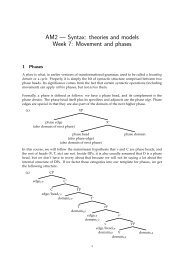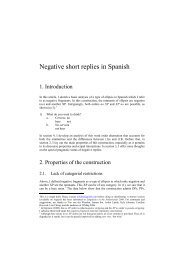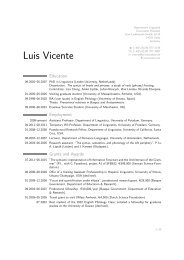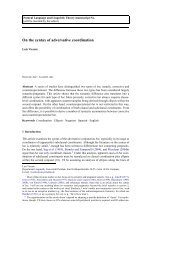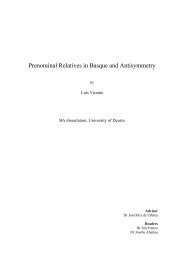Verb fronting in Mandarin Chinese - Luis Vicente
Verb fronting in Mandarin Chinese - Luis Vicente
Verb fronting in Mandarin Chinese - Luis Vicente
You also want an ePaper? Increase the reach of your titles
YUMPU automatically turns print PDFs into web optimized ePapers that Google loves.
Cheng & <strong>Vicente</strong><br />
<strong>Verb</strong> <strong>front<strong>in</strong>g</strong> <strong>in</strong> Mandar<strong>in</strong><br />
UCSC L<strong>in</strong>guistics Colloquium<br />
October 31, 2008<br />
An <strong>in</strong>terface solution? — what the splitt<strong>in</strong>g effect is tell<strong>in</strong>g us is that double pronunciation <strong>in</strong><br />
this case is not reducible to morpho-phonological requirements. Rather, someth<strong>in</strong>g external (<strong>in</strong>terface<br />
conditions, cf. Bobaljik 2002) forces both positions to have some phonetic realization. In this case, we<br />
can get away with partial spellout because recoverability is not an issue.<br />
If someth<strong>in</strong>g like this is viable, there is still the question of how to restrict it to verbal clefts. This is<br />
someth<strong>in</strong>g we still don’t know how to do.<br />
6 Conclusions<br />
• Syntactically, verbal clefts and verbal lian...dou are unexceptional: they are <strong>in</strong>stances of the<br />
more general cleft and lian...dou constructions and, as <strong>in</strong> many other languages, they <strong>in</strong>volve<br />
A-bar movement of a verbal constituent.<br />
• Semantically, there isn’t much to report either. <strong>Verb</strong>al clefts exhibit the verum focus read<strong>in</strong>g<br />
observed <strong>in</strong> predicate clefts <strong>in</strong> several other languages. <strong>Verb</strong>al lian...dou sentences have the even<br />
mean<strong>in</strong>g characteristic of the lian...dou construction.<br />
• Phonologically, however, th<strong>in</strong>gs are trickier. We have show that the trigger for double pronunciation<br />
must be different for each construction.<br />
Various issues left to solve:<br />
• Why is the presence of negation obligatory <strong>in</strong> verbal lian...dou?<br />
• Why do verbal lian...dou and (to a lesser extent) verbar clefts require the lower copy of the verb<br />
to be clause f<strong>in</strong>al?<br />
• What is the proper characterization and analysis of the splitt<strong>in</strong>g effect with bisyllabic verbs <strong>in</strong><br />
verbal clefts?<br />
12 of 13



